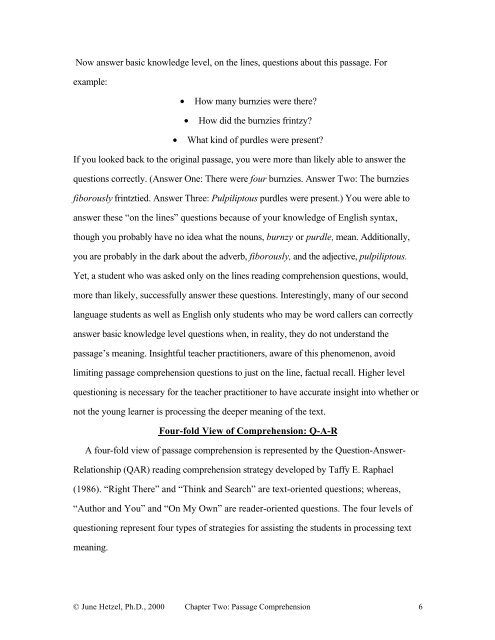Reading in the Elementary Classroom Chapter Two: Passage ...
Reading in the Elementary Classroom Chapter Two: Passage ...
Reading in the Elementary Classroom Chapter Two: Passage ...
Create successful ePaper yourself
Turn your PDF publications into a flip-book with our unique Google optimized e-Paper software.
Now answer basic knowledge level, on <strong>the</strong> l<strong>in</strong>es, questions about this passage. For<br />
example:<br />
• How many burnzies were <strong>the</strong>re?<br />
• How did <strong>the</strong> burnzies fr<strong>in</strong>tzy?<br />
• What k<strong>in</strong>d of purdles were present?<br />
If you looked back to <strong>the</strong> orig<strong>in</strong>al passage, you were more than likely able to answer <strong>the</strong><br />
questions correctly. (Answer One: There were four burnzies. Answer <strong>Two</strong>: The burnzies<br />
fiborously fr<strong>in</strong>tztied. Answer Three: Pulpiliptous purdles were present.) You were able to<br />
answer <strong>the</strong>se “on <strong>the</strong> l<strong>in</strong>es” questions because of your knowledge of English syntax,<br />
though you probably have no idea what <strong>the</strong> nouns, burnzy or purdle, mean. Additionally,<br />
you are probably <strong>in</strong> <strong>the</strong> dark about <strong>the</strong> adverb, fiborously, and <strong>the</strong> adjective, pulpiliptous.<br />
Yet, a student who was asked only on <strong>the</strong> l<strong>in</strong>es read<strong>in</strong>g comprehension questions, would,<br />
more than likely, successfully answer <strong>the</strong>se questions. Interest<strong>in</strong>gly, many of our second<br />
language students as well as English only students who may be word callers can correctly<br />
answer basic knowledge level questions when, <strong>in</strong> reality, <strong>the</strong>y do not understand <strong>the</strong><br />
passage’s mean<strong>in</strong>g. Insightful teacher practitioners, aware of this phenomenon, avoid<br />
limit<strong>in</strong>g passage comprehension questions to just on <strong>the</strong> l<strong>in</strong>e, factual recall. Higher level<br />
question<strong>in</strong>g is necessary for <strong>the</strong> teacher practitioner to have accurate <strong>in</strong>sight <strong>in</strong>to whe<strong>the</strong>r or<br />
not <strong>the</strong> young learner is process<strong>in</strong>g <strong>the</strong> deeper mean<strong>in</strong>g of <strong>the</strong> text.<br />
Four-fold View of Comprehension: Q-A-R<br />
A four-fold view of passage comprehension is represented by <strong>the</strong> Question-Answer-<br />
Relationship (QAR) read<strong>in</strong>g comprehension strategy developed by Taffy E. Raphael<br />
(1986). “Right There” and “Th<strong>in</strong>k and Search” are text-oriented questions; whereas,<br />
“Author and You” and “On My Own” are reader-oriented questions. The four levels of<br />
question<strong>in</strong>g represent four types of strategies for assist<strong>in</strong>g <strong>the</strong> students <strong>in</strong> process<strong>in</strong>g text<br />
mean<strong>in</strong>g.<br />
© June Hetzel, Ph.D., 2000 <strong>Chapter</strong> <strong>Two</strong>: <strong>Passage</strong> Comprehension 6


